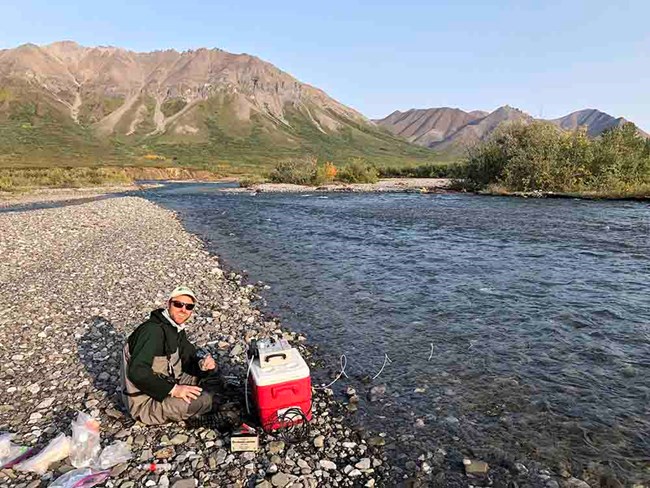Last updated: December 1, 2020
Article
Improving our understanding of carbon chemistry and reactivity in streams across permafrost regions

Dissolved organic matter (DOM) is a mixture of carbon-containing molecules that are soluble in water. In Arctic streams, most DOM originates from plants and soils in surrounding terrestrial landscape. The transport of DOM in streams and rivers functions as an important component of water quality, ecosystem productivity, and the global carbon cycle. However, much uncertainty exists about factors controlling the breakdown of DOM (i.e., microbial degradation), which in turn can drive nutrient availability in streams and greenhouse gas release. Here, we conducted an experiment to assess the role of chemical factors on DOM breakdown by stream microbes. Water samples were collected from streams and rivers across the permafrost regions of Alaska, Canada, Scandinavia, Siberia, and the Tibetan Plateau. Our main findings show that DOM chemistry is remarkably similar across these regions. The addition of nutrients (nitrogen and phosphorus) and acetate (a simple carbon compound) actually slowed rates of bulk DOM breakdown relative to control treatments, but increased breakdown of certain chemical forms of DOM. These findings will help to constrain projections of carbon release to the atmosphere from inland waters across the Arctic under warming and thawing scenarios.
Stream dissolved organic matter in permafrost regions shows surprising compositional similarities but negative priming and nutrient effects
Abstract
Permafrost degradation is delivering bioavailable dissolved organic matter (DOM) and inorganic nutrients to surface water networks. While these permafrost subsidies represent a small portion of total fluvial DOM and nutrient fluxes, they could influence food webs and net ecosystem carbon balance via priming or nutrient effects that destabilize background DOM. We investigated how addition of biolabile carbon (acetate) and inorganic nutrients (nitrogen and phosphorus) affected DOM decomposition with 28‐day incubations. We incubated late‐summer stream water from 23 locations nested in seven northern or high‐altitude regions in Asia, Europe, and North America. DOM loss ranged from 3% to 52%, showing a variety of longitudinal patterns within stream networks. DOM optical properties varied widely, but DOM showed compositional similarity based on FT‐ICR MS analysis. Addition of acetate and nutrients decreased bulk DOM mineralization (i.e., negative priming), with more negative effects on biodegradable DOM but neutral or positive effects on stable DOM. Unexpectedly, acetate and nutrients triggered breakdown of colored DOM (CDOM), with median decreases of 1.6% in the control and 22% in the amended treatment. Additionally, the uptake of added acetate was strongly limited by nutrient availability across sites. These findings suggest that biolabile DOM and nutrients released from degrading permafrost may decrease background DOM mineralization, but alter stoichiometry and light conditions in receiving waterbodies. We conclude that priming and nutrient effects are coupled in northern aquatic ecosystems, and that quantifying two‐way interactions between DOM properties and environmental conditions could resolve conflicting observations about the drivers of DOM in permafrost zone waterways.
Wologo, E., S. Shakil, S. Zolkos, S. Textor, S. Ewing, … J. A. O’Donnell, et al. 2020. Stream dissolved organic matter in permafrost regions shows surprising compositional similarities but negative priming and nutrient effects. Global Biogeochemical Cycles: e2020GB006719.
